Historical Background
Chapter 2: The Cossacks
Matthew Maischoss and Sebastian Parilov
The Cossacks were originally nomads. Many of them spread across Russia, Kazakhstan, Bulgaria, and Ukraine. In this chapter, we focus on the Ukrainian Cossacks and their contributions to the history of Ukraine, both internally and internationally.
The first Cossacks lived in small bands across the steppes (dry, grassy areas covering vast plains), and specifically the Pontic-Caspian steppe, a region that stretched from the Black Sea to the Caspian Sea. The Cossacks tended to live a meager and subsistence-level life, and they preyed on merchants and the cargo they carried. Additionally, they often served as mercenaries or soldiers of fortune. Over time, the Cossack population increased, becoming a nuisance for their enemies but making them reliable and useful allies.
.
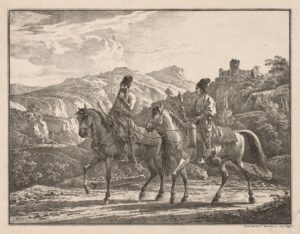
First Sightings
A primary goal for the Crimean Tatars in the thirteenth century occupying Ukraine was acquiring enslaved Ukrainians. One of the slave routes for the Crimean Tatars was west of the Dnieper river, deep in the Ukrainian lands. The slave trade would have continued if not for the Cossacks stepping in to challenge the Tatars. In 1493, the Cossacks attacked and pillaged a Tatar ship, resulting in a Lithuanian Duke being notified about the attack. Grand Duke Alexander sent in the Ukrainian officials to investigate the area and execute any people involved, but nothing came of the investigation. The Cossacks were spotted again in 1499, ravaging the Tatar fortress at Ochakiv. Ochakiv was located near the Dnieper estuary, where the Dnieper river meets the Bug river. The Ochakiv fortress would be a long-contested place due to its strategic location.
The Lithuanian Grand Duke soon realized that the Cossacks could be helpful to the Lithuanians, as the Cossacks were a perfect armed band to protect Lithuanian borders from the Tatars. In 1553, Prince Mykhailo Vyshnevetsky was sent by the Grand Duke to build a fortress beyond the Dnieper rapids to stop the Cossack expeditions. The fortress was constructed with the use of Cossack labor. However, the Tatar Khan saw this fortress as an invasion of his land, and in 1557 an army was sent to destroy the Cossacks. Not much is known about the ensuing battle, but we know that Vyshnevetsky was victorious and allegedly became one of the first popular Cossack hetmans (leaders).
Rebellions
The lands south of Kyiv became lively with new settlements in the mid-16th century. These settlements included a large number of migrating peasants, people fleeing slavery or hiding from the government, and newcomers attracted to the rich and fertile land in Ukraine. The Cossacks still pillaged, but they also fished and hunted in their settlements to survive. While they may have lived in poor huts, the conditions inside were “full of expensive sils, precious stones, sables and other furs, and spices,” wrote Michalon the Lithuanian.
In 1559, the Volhynian princes elected Kostiantyn Ostrozky to become a palatine, having local authority that elsewhere belonged only to a sovereign of Kyiv. Ostrozky was one of the first to include Cossacks in the military for the Livonian War. Not much is known about this first regiment of Cossacks. In the 1590s, the Polish-Lithuanian Commonwealth increased the Cossack force to a thousand registered Cossacks. Registered Cossacks could obtain special rights associated with royal service, were exempt from paying taxes, and were not subjected to jurisdiction by local officials. These registered Cossacks were deployed to protect the Ukrainian borderlands from the Tatars. However, these Cossacks soon turned their attention back to Ukraine to rebel against the Volhynian princes.
Polish-Cossack relations were never friendly; one was always having serious problems with the other. It is essential to know that the Cossacks remained a big nuisance to the Crimean Tatars, whom the Poles did not wish to agitate. Therefore, the Polish government asked the Cossacks to leave the settlements beyond the rapids. Additionally, they did not recognize the Cossack towns and villages, even though the Cossacks helped the Polish-Lithuanian Commonwealth in military operations. The Poles saw the Cossacks as an illegitimate group: since the Poles had legal ownership of the lands near the Dnieper river, they imposed feudal dependency over the people living there and required labor of them. The only Cossacks who were exempt from taxes and forced work were the registered Cossacks. The other Cossacks were forced into serfdom, which angered the Cossacks and led to the first Cossack uprising in 1591.
The Ostrozky family had absolute control over the region, and they used that control to extend their land by taking over lands that were owned by other nobility. Kryshtof Kosynsky’s land was appropriated by a member of the Ostrozky family named Janusz Ostrozky. Instead of filing a complaint to the King of Poland, Kosynsky gathered his forces and began a revolt against Ostrozky. Lasting from 1591 to 1593, Kosynsky’s uprising was initially very successful, capturing the towns of Pykiv, Bilohorodka, and Chudniv. Then, Kosynsky attacked Janusz Ostrozky’s prized possession, the Bila Tserkva castle. Ostrozky was not present as he had run away, so instead, the Cossacks took Pereyaslav and Trypillia, destroying the nobles’ residences.
The first resistance faced by the Cossack army was at Chyhyryn. It was a total defeat for the Polish military, as the Cossack army grew increasingly vast with runaways from Polish estates to other Cossack forces in the surrounding regions. The Polish government finally responded to the revolt when the Cossacks moved into Polish territory, including the regions of Volyn and Bratslav. However, the royal authorities from Poland would not help in suppressing this uprising; instead, a private army was assembled by the Ostrozkys and Prince Oleksandr Vyshnevetsky. Hearing the news, Kosynsky moved his army from Kostiantynivka to Pyatka, as he knew the war would either destroy or conserve the rebellion. Unfortunately for Kosynsky, the Poles broke through Cossack defenses in 1593, forcing Kosynsky’s forces to retreat to Pyatka. There, Kosynsky was forced to surrender to the Polish troops, and his rebellion was finally squashed in 1593. Others would soon follow in his footsteps.
During the surrender and retreat of the rebelling Cossacks, Severyn Nalyvaiko, another Cossack chieftain in Ostrozky’s service (yes, the Poles hired other Cossacks to fight the Cossacks), assembled the scattered Cossacks and took them further into the steppes of Podolia away from Ostrozky’s land. Ostrozky noticed this movement and put Nalyvaiko in charge of the Cossacks. Nalyvaiko would soon realize that there was more than one group of Cossacks, as a new group called the Zaporozhian Cossacks emerged. This new group consisted primarily of peasants, who constructed a new settlement called the Sich on an island beyond the rapids. The settlement was strategically located, as the Polish royals were unable to interfere with them, and from there they could cause a lot of discomfort for the Crimean Tatars.
Nalyvaiko soon created an uneasy alliance with the Zaporozhian Cossacks, and in 1594 he started to do his own bidding, not in partnership with Ostrozky. As the previous rebellion started, Nalyvaiko’s army captured many cities in present-day Belarus with the help of burghers and urban dwellers. They overtook Bratslav, Husiatyn, Bar, Lutsk, Kaniv, Cherkasy, Slutsk, Babruisk, and Mahiliou. In 1595, the Polish government sent Stanisław Żółkiewski, a Polish hetman, to deal with Nalyvaiko. The Poles were able to push the Cossack army out of Belarus. However, in 1596, having united with Matvii Shaula’s Zaporozhians, they won a significant battle at Bila Tserkva and retreated to Pereiaslav. There, the Poles surrounded the Cossacks. After a two-week bombardment, a mutiny arose within the camp, and the leaders Shaula and Nalyvaiko were handed over to the Poles for peace. During the peace negotiations, however, the Polish army attacked the remaining Cossacks and brutally murdered almost the entire camp: only 1,500 survived, retreating to Zaporizhia. Nalyvaiko was taken back to Poland, tortured, and beheaded in a public display.
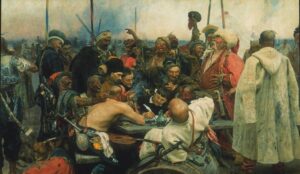
Polish “Alliance”
In the 1550s, the Cossacks served Ivan the Terrible as mercenaries for hire. They helped Ivan reconquer the Volga River from the Tatars by attacking and successfully capturing Kazan and Astrakhan. However, in the 1600s, the Rurikid dynasty died out from devastating famine and historic low temperatures. As the throne stood empty, there were many vying to make it theirs. The Cossacks supported two candidates for the throne: False Dmitrii I and False Dmitrii II. The Cossacks also joined the Polish army as they marched into Russia in 1610, when Russia had formed a military alliance with Sweden. The aim was for Poland to gain territory and weaken Russia. On July 4, 1610, the Polish-Lithuanian army defeated a much bigger Russian-Swedish army at Klushino. With 679 Cossacks on horseback attacking the Russian-Swedish camp by surprise, a five-hour battle ensued, and the Polish army rose to victory.
The Polish forces entered Moscow and placed Prince Władysław of Poland on the throne as the Tsar, with the condition that Muscovites would be converted to Catholicism. The Russian boyars were not pleased with this decision, prompting multiple revolts in an attempt to drive the Polish out. In 1613, Mikhail Romanov was elected as the Tsar of Russia. Five years later, the Polish army besieged the capital along with 20,000 Cossacks. With the help of the Cossacks, they signed the Truce of Deulino, which granted Russian independence and gave the Polish-Lithuianian Commonwealth such territories as Severia and Chernihiv, the latter of which would become an important Cossack stronghold.
The Cossacks’ cooperation with the Poles would not stop there. The Ottomans were stirring up trouble against the Poles and the Cossacks, who were continuously raiding them. From 1606 to 1616, Cossacks would storm and pillage cities, and rob Ottoman ships. This activity caught the ear of the Christian rulers, who were viewing the Cossacks as potential allies against the Ottomans. However, while Count Philippe was notifying the French King about these possible allies, the Ottoman Empire marched toward the Commonwealth in 1620. Near the town of Țuțora, an Ottoman army of 20,000 crushed the opposing Polish army of 10,000. After this defeat with heavy losses, the Commonwealth was in a panic as it no longer had a standing army. The Commonwealth turned again to the Cossacks asking for help; the latter agreed to assist and sent 40,000 Cossack troops to Moldavia. Meanwhile, Petro Konaskevych-Sahaidachny was sent to Warsaw to ask for increased privileges for the Cossacks. The Cossack army crossed the Dniester River into Moldavia and slowed the Turkish forces heading towards the Polish encampment near Khotny. However, not trusting the Poles, the Cossack army would not advance until Sahaidachny informed the Cossacks that the Polish parliament had agreed to the terms. Encamped in the fortress of Khotyn, the Polish and Cossack armies slowed down the Ottoman forces. The siege lasted a month with no clear winner, with both sides suffering major casualties.
Despite this lackluster outcome, the Poles saw this result as a victory, as they had stopped a massive army of 150,000 troops with no change of borders for the Commonwealth. Additionally, the Cossacks became favored by the Commonwealth thanks to their significant help in the war. The achievement of the war against the Ottomans allowed the Cossacks to advocate for their political and social agenda. One of the main requests was for Cossacks officers to receive noble status. Unfortunately, this aim was never achieved; instead, the Polish army reduced the number of mobilized Cossacks from 40,000 to 5,000. The Cossacks did not agree with the drastic decrease in their number, and Marek Zhmaylo led a revolt. Although the Cossacks inflicted major casualties on the Poles near Lake Kurukove, they were nevertheless forced to surrender, with Marek Zhmaylo being removed as the Cossack hetman for this loss. The Cossacks tried again to advance their agenda, and in 1630 under hetman Taras Fedorovych they defeated the Polish army at Korsun and Pereiaslav, forcing the Poles to sign the Treaty of Pereiaslav. The treaty would increase the number of registered Cossacks to 8,000; however, they were instructed to stop raiding the Ottomans and return artillery pieces that they had captured during the battles.
Poland soon realized this was not a long-term solution to their Cossack problem. In 1637 and 1638, Cossacks attempted two more revolts, both of them crushed by the Polish army. The Poles nevertheless passed the Cossack Ordinance of 1638, in which the Polish royalty recognized the Cossack state with its own rights and privileges. However, the Polish government placed certain restrictions on them, such as limiting their activities to Cossack towns. Additionally, Polish authorities limited the number of registered Cossacks to 6,000 and placed them under the jurisdiction of the Polish Commander in Chief. While getting their own state was a significant achievement for the Cossacks, this treaty put them entirely under the control of the Poles.
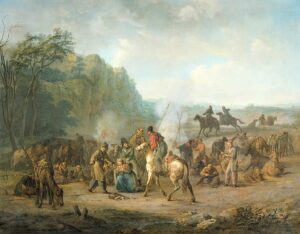
The Polish-Cossack War
The Cossacks were not fully satisfied with the 1638 treaty, and they were restrained from raiding as the Poles wanted better relations with the Ottomans. This development led to more turmoil between the Poles and Cossacks in subsequent years. In 1648, Cossack chieftain Bohdan Khmelnytsky marched against the Poles. His victories kept adding numbers to his army, which included members of the Ukrainian clergy, dissatisfied peasants, and townspeople. In October of 1648 Khmylnytsky occupied Lwów (now Lviv), but he did not stop there; he wanted complete separation from Poland. The Poles were not ready to give up the Cossacks: Jan II Casimir Vasa (who was supported by Khmelyntsky in his bid to become the new Polish king) mobilized 25,000 troops along with the Lithuanian army to march on Kyiv. In July, Khmelnytsky and Islam-Girei III, Khan of the Crimean Tatars, surrounded part of the king’s army in Zbarazh. In retaliation, Jan II Casimir Vasa sent 25,000 troops to aid the surrounding forces. However, in a surprise attack on August 15th, the Cossacks and Crimean Tatar army attacked at Zboriv on the Strypa River. The 300,000-plus Cossack and Tatar force was formidable, and victory over Poland seemed imminent, but it was never achieved. At the last minute, Islam-Girei III was bribed by the Polish army and withdrew his forces. Following the Khan’s departure, the Poles enacted the Compact of Zborów through which the Cossack people received a semi-independent state. Still, much of the population remained subjected to Polish landowners, and 18 months later turmoil continued.
This time, the Cossacks were not fighting the Poles alone. With the help of the Turkish sultan, the Cossack army was reinforced by the sultan’s vassal and khan of the Crimean Tatars. The two armies met on the Styr River in Volhynia, south of Lutsk, in the Battle of Beresteczko. The Tatar-Cossack force was predicted to destroy the Poles, but during the battle the Tatar khan and his army left the battlefield for a second time (the reasons for which remain unclear). Still, many historians believe they left either in an act of treasonous desertion, or to create a line of defense to protect Kyiv from the advancing Lithuanian army. Regardless of the reason, the Khan’s defection enabled the Polish military to execute a swift and easy victory over the Cossacks. In light of this Polish triumph, a new peace settlement was negotiated in September 1651 at Biała Cerkiew. This treaty reduced the number of registered Cossacks to 20,000 (half the original number), and forced Khmelnytsky to end the Cossack alliance with the Crimean Tatars and other independent foreign relations.
The Cossacks being the Cossacks, they continued to fight against the Poles for their country. Disregarding the previous treaty, they strengthened their ties with the Tatars and the Porte, or Ottoman empire. Additionally, Khmelyntsky betrothed his son to the Moldavian princess, aiming to further reinforce his alliance with the Principality of Moldavia. In 1652, Khmelyntsky sent his son, Tymish Khmelnytsky, to Moldavia to marry the princess accompanied by a large army of Cossacks and Tatars. However, on May 23rd, Tymish and his army encountered Polish forces numbering 30,000 men amassing to stop the marriage. In the ensuing battle at Batozka Bytva, the Polish military, expecting reinforcements, encircled the Cossack army and prepared to attack. But on the morning of the 23rd, the Cossack army attacked the Polish camp and, by the end of the day, had destroyed almost all of the 30,000 men, including the Grand Crown Hetman Marcin Kalinowski and most of his staff. This battle is one of Khmelyntsky’s greatest achievements. In light of this victory, the treaty at Biała Cerkiew was rescinded, allowing Tymish Khmelnytsky to marry the Moldavian princess. Unfortunately, this major victory was short-lived: in 1653, the Moldavian boyars revolted against Tymish and ultimately killed him on 15 September 1653, closing the door to a Moldavian alliance.
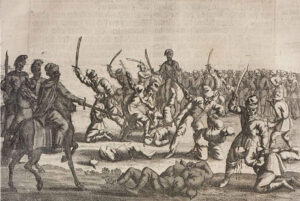
Diplomatic Relations
The Cossacks and Muscovy had maintained diplomatic relations with each other throughout this time. However, the Russian Tsar did not support the Cossack revolts, which could have led to a war with the Poles. With the Cossacks becoming an independent state, Moscow signed a treaty with the Cossacks in 1654. The Pereiaslav Treaty of 1654 began Russia’s encroachment into Ukraine, with Ukraine becoming a protectorate of the Tsar and agreeing not to participate in talks with Poland or the Ottomans without the Tsar’s permission. In exchange, Russia would recognize the Cossack hetman and allow for free elections, and Muscovy would defend Ukraine against attack Poland if needed. However, both sides read the treaty in different ways. Bohdan Khmelyntsky had thought it a temporary treaty, while Muscovy used the treaty to become more involved in internal Ukrainian affairs following Khmelyntsky’s death. The two countries led an offensive against the Poles with Muscovy on the Cossacks’ side. In 1654, the armies entered Belarus and took over Smolensk, capturing more and more of Belarus; tensions began to arise around who should control the newly acquired territories. Meanwhile, the Poles attacked the Bratslav region and besieged Uman. In one of the final battles of the Polish-Cossack war, the Muscovite-Cossack army was sacked and lost 9,000 troops, forcing the army to retreat east.
As the war was coming to an end, the Cossacks were becoming more and more frustrated with their Russian allies. In addition, Sweden was taking advantage of the war, capturing part of Poland and Lithuania. Worried about Swedish expansion, Moscow signed the Vilnius Peace Treaty with Poland in 1656. Unfortunately, the Ukrainian government was not present in the peace negotiations. Therefore, they joined forces with the Swedish army to capture Western Ukrainian territories with the aim of uniting them with the rest of Ukraine. At first, the alliance appeared to be effective: the Ukrainian-Transylvanian army consisting of 30,000 Hungarians and 20,000 Cossacks occupied Galicia, which included Kraków and Warsaw. But the army was soon forced to retreat, with Muscovite agents sabotaging the Cossack army. In July 1657, the Cossacks and Hungarians were forced to sign the Treaty of Chornyi, ending the Cossack-Polish war.
During the 17th century, Ukrainian Cossacks who had once been under Polish rule switched sides to the Russian imperialists. With tensions between the Polish royals and ruling elites at an all-time high, the Cossacks decided to revolt against the Polish monarchy. While they had hopes of keeping their culture and autonomy under Russian rule, their independence was challenged as they were integrated into Russia’s military society. As a result, Ukrainian Cossacks experienced many struggles throughout the 18th century under Russian rule.
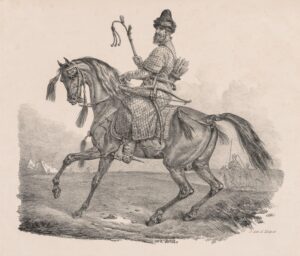
Between 1700 and 1721, many Cossacks lost their independence under Russian rule; consequently, many Cossacks revolted against the Russians who dominated the area. Hetman Ivan Mazepa, a leader and a hero in the eyes of many Cossacks at the time, pledged over 5,000 Cossacks troops to the Swedish King Charles XII during the Great Northern War. This War was caused by Sweden’s rapid expansion in the Balkans area, causing Russia, Saxony-Poland, and Denmark-Norway to form a coalition in 1698. The Cossacks saw this alliance as an opportunity to overthrow Russians controlling the area; however, it resulted in Sweden losing. Sweden’s loss caused Russia to gain more power and influence in the Baltics, leading to the end of Cossack’s independence.
In 1721, Russia took over most of what is now modern-day Ukraine. Russia placed General Petr Rumiantsev, a distinguished general and a diehard Russian patriot, in charge of “Little Russia.” In his new role as the governor, he was given control of all military men in the area. Rumiantsev abolished the Cossack military and administrative system and integrated them into the Russian Imperial military. Cossack men were forced to serve at least 20 years in the Russian military. In 1768, Russian soldiers crossed the Dnieper border to put down the Catholic confederates, Orthodox Cossacks, and the peasants in the area. A Russian Cossack regiment crossed the border into Poland in pursuit of the Catholic Confederates, then crossed into Crimean Khanate territory. The Ottoman Empire and the French used this event to declare War on the Russian Empire in 1768.
In 1773-1774, the Pugachev Rebellion occurred — a massive Cossack uprising that led to the dissolution of Cossacks. Many were hunted down and killed, or were forced to join Russian Cossack regiments. Many Cossacks who supported the Russian Empire became part of the elite, ruling the Hetmanate and Sloboda Ukraine. Cossacks came to enjoy such imperial perks and public services as school and postal systems. Additionally, many Cossack officers were able to own land, which caused much of the peasantry to live on land owned by military officials. By the end of the 18th century, most of modern-day Ukraine had been taken over by Russia. Its hierarchical system of estates rewarded subjects for the amount of service they completed in the military. Imperial Russia additionally awarded land to many Cossacks, alongside exemptions from taxation due to their extended service time. A number of the military officers who led the Decembrist uprising of 1825 were descendants of prominent Cossack families hoping for Russia to adopt a constitution. The revolt was crushed, sparking a thirty-year period of conservative rule under Emperor Nicholas I.
From 1853 to 1856, another battle between Russia and the Ottoman Empire erupted; by this time Cossacks were heavily integrated into military regiments. In 1854, France, Great Britain, and Sardinia-Piedmont joined the battle on the side of the Ottomans. This event resulted in the Treaty of Paris being signed, with the Ottomans’ allies guaranteeing its independence and territorial integrity. Russia was forced to surrender Bessarabia to Moldavia, causing Russia to stop all military and naval activities in the Black Sea. In 1855, a peasant revolt occurred toward the war’s end called the Kyiv Cossacks Revolt. It spread throughout the Kyiv region, affecting more than 500 villages. The revolt was a response to Tsar Nicholas’s manifesto to gain more support for the war, which was aimed at the peasantry. Due to miscommunication, vague wording in the manifesto, and rumors, many believed the Tsar wanted them to form Cossack regiments. Many also believed that in so doing, the Tsar aimed to restore privileges to the Cossack estates. With hopes of gaining wealth and status, many elected not to follow orders (feeling they were no longer peasants), and began forming their own communities with local militias. Russia sent regular military regiments to put down these Cossack militias, but at a high cost with myriad bloody battles. The militias were finally put down and the revolt ended; even so, it revealed the strength of the Cossack culture and traditions.

